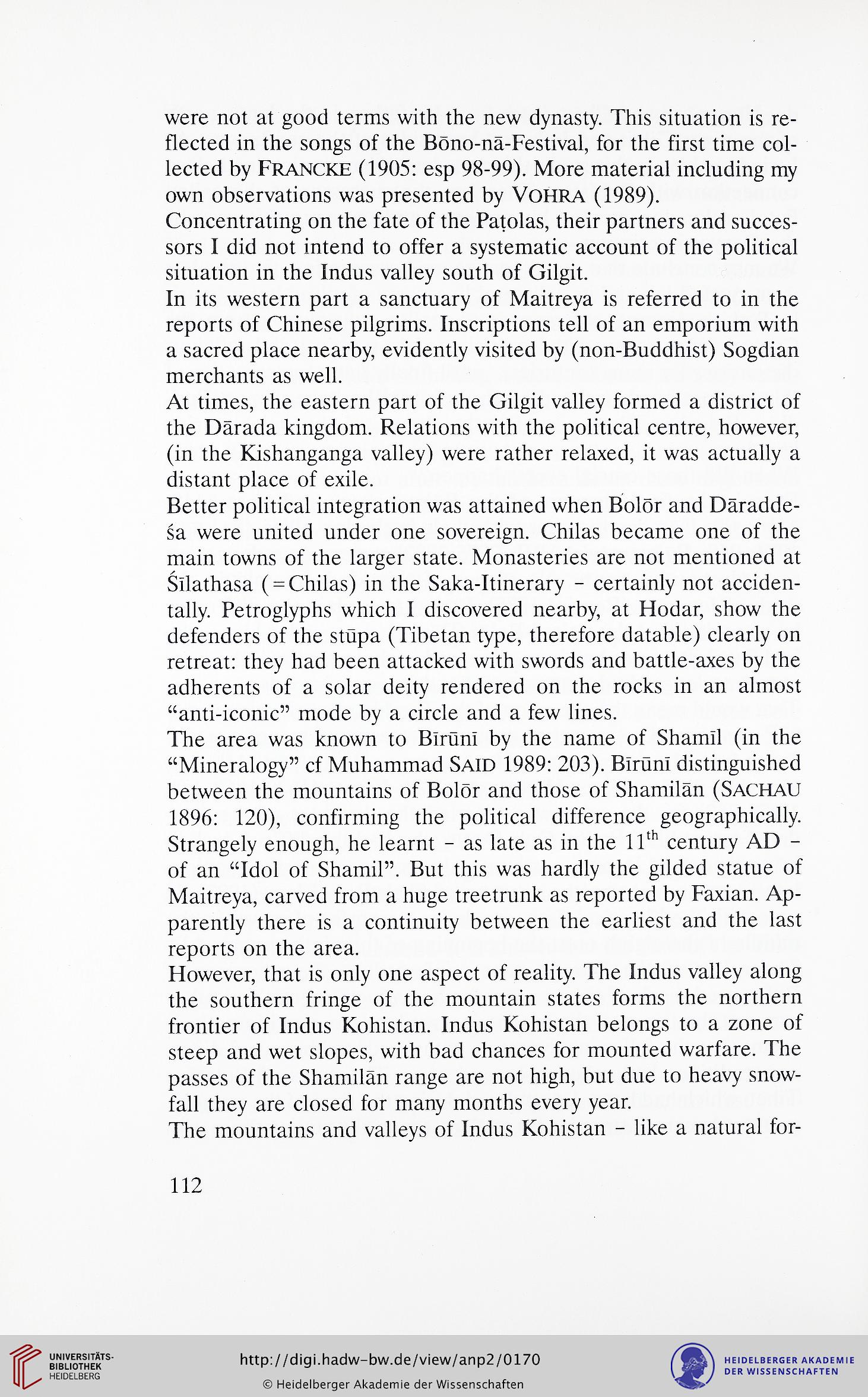were not at good terms with the new dynasty. This situation is re-
flected in the songs of the Böno-nä-Festival, for the first time col-
lected by FRANCKE (1905: esp 98-99). More material including my
own observations was presented by VOHRA (1989).
Concentrating on the fate of the Patolas, their partners and succes-
sors I did not intend to offer a systematic account of the political
situation in the Indus valley south of Gilgit.
In its western part a sanctuary of Maitreya is referred to in the
reports of Chinese pilgrims. Inscriptions tell of an emporium with
a sacred place nearby, evidently visited by (non-Buddhist) Sogdian
merchants as well.
At times, the eastern part of the Gilgit valley formed a district of
the Därada kingdom. Relations with the political centre, however,
(in the Kishanganga valley) were rather relaxed, it was actually a
distant place of exile.
Better political integration was attained when Bolör and Däradde-
sa were united under one sovereign. Chilas became one of the
main towns of the larger state. Monasteries are not mentioned at
Sllathasa ( = Chilas) in the Saka-Itinerary - certainly not acciden-
tally. Petroglyphs which I discovered nearby, at Hodar, show the
defenders of the stüpa (Tibetan type, therefore datable) clearly on
retreat: they had been attacked with swords and battle-axes by the
adherents of a solar deity rendered on the rocks in an almost
"anti-iconic" mode by a circle and a few lines.
The area was known to Bïrùni by the name of Shamil (in the
"Mineralogy" cf Muhammad SAID 1989: 203). Blrünî distinguished
between the mountains of Bolör and those of Shamilän (SACHAU
1896: 120), confirming the political difference geographically.
Strangely enough, he learnt - as late as in the 11^ century AD -
of an "Idol of Shamil". But this was hardly the gilded statue of
Maitreya, carved from a huge treetrunk as reported by Faxian. Ap-
parently there is a continuity between the earliest and the last
reports on the area.
However, that is only one aspect of reality. The Indus valley along
the southern fringe of the mountain states forms the northern
frontier of Indus Kohistan. Indus Kohistan belongs to a zone of
steep and wet slopes, with bad chances for mounted warfare. The
passes of the Shamilän range are not high, but due to heavy snow-
fall they are closed for many months every year.
The mountains and valleys of Indus Kohistan - like a natural for-
112
flected in the songs of the Böno-nä-Festival, for the first time col-
lected by FRANCKE (1905: esp 98-99). More material including my
own observations was presented by VOHRA (1989).
Concentrating on the fate of the Patolas, their partners and succes-
sors I did not intend to offer a systematic account of the political
situation in the Indus valley south of Gilgit.
In its western part a sanctuary of Maitreya is referred to in the
reports of Chinese pilgrims. Inscriptions tell of an emporium with
a sacred place nearby, evidently visited by (non-Buddhist) Sogdian
merchants as well.
At times, the eastern part of the Gilgit valley formed a district of
the Därada kingdom. Relations with the political centre, however,
(in the Kishanganga valley) were rather relaxed, it was actually a
distant place of exile.
Better political integration was attained when Bolör and Däradde-
sa were united under one sovereign. Chilas became one of the
main towns of the larger state. Monasteries are not mentioned at
Sllathasa ( = Chilas) in the Saka-Itinerary - certainly not acciden-
tally. Petroglyphs which I discovered nearby, at Hodar, show the
defenders of the stüpa (Tibetan type, therefore datable) clearly on
retreat: they had been attacked with swords and battle-axes by the
adherents of a solar deity rendered on the rocks in an almost
"anti-iconic" mode by a circle and a few lines.
The area was known to Bïrùni by the name of Shamil (in the
"Mineralogy" cf Muhammad SAID 1989: 203). Blrünî distinguished
between the mountains of Bolör and those of Shamilän (SACHAU
1896: 120), confirming the political difference geographically.
Strangely enough, he learnt - as late as in the 11^ century AD -
of an "Idol of Shamil". But this was hardly the gilded statue of
Maitreya, carved from a huge treetrunk as reported by Faxian. Ap-
parently there is a continuity between the earliest and the last
reports on the area.
However, that is only one aspect of reality. The Indus valley along
the southern fringe of the mountain states forms the northern
frontier of Indus Kohistan. Indus Kohistan belongs to a zone of
steep and wet slopes, with bad chances for mounted warfare. The
passes of the Shamilän range are not high, but due to heavy snow-
fall they are closed for many months every year.
The mountains and valleys of Indus Kohistan - like a natural for-
112




